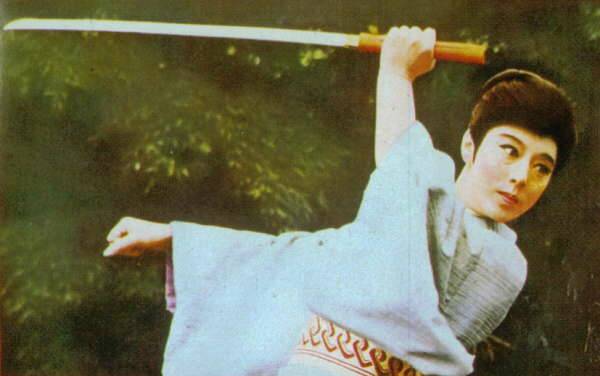 “Up to bat…”
“Up to bat…”
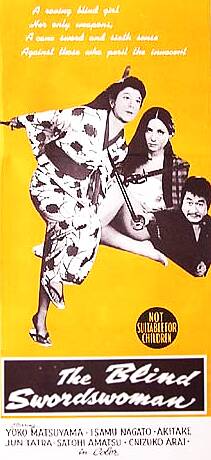 While the samurai is one of the most common archetypes in Japanese cinema, the female version is about as rare as the female gunslinger. Although none of these women reached anything like the popularity of Zatoichi – 26 films starring Shintaro Katsu alone, never mind the recent Takeshi Kitano version – there have been a few that have attempted to break the mould. Azumi and The Princess Blade have both achieved cult status in the West, assisted by Tarantino’s take in Kill Bill, Volume 1. Back in 1973, there was Lady Snowblood, which was successful enough to merit a sequel the following year, but so far, only one samurai-ess series has survived more than two outings.
While the samurai is one of the most common archetypes in Japanese cinema, the female version is about as rare as the female gunslinger. Although none of these women reached anything like the popularity of Zatoichi – 26 films starring Shintaro Katsu alone, never mind the recent Takeshi Kitano version – there have been a few that have attempted to break the mould. Azumi and The Princess Blade have both achieved cult status in the West, assisted by Tarantino’s take in Kill Bill, Volume 1. Back in 1973, there was Lady Snowblood, which was successful enough to merit a sequel the following year, but so far, only one samurai-ess series has survived more than two outings.
That swordswoman is Oichi, supposedly based on an animated story and character by Teruo Tanashita – but, really, who are they trying to kid? This was simply the Shochiku’s studio’s answer to Daiei’s Zatoichi, and any protestations to the contrary should be treated with deep scepticism. Both hero and heroine are blind, yet have no problem fighting for truth, justice and the Amer…Japanese way, as they wander through the traditional chambara landscape. [Indeed, in the first film, a blind masseuse wobbles drunkenly through one scene, in what can only be a casual potshot at Zatoichi] Original thought is not something to look for in the Crimson Bat series, even ardent fans will admit. However, Shochiku did strike gold in Yuko Matsuyama; albeit they didn’t have to look very far to find her, since she was married to character creator Tanashita. I get the feeling Shochiku didn’t exactly over-exert themselves in a star search.
With the success of Kill Bill, it seems a little strange that no-one has seen fit to give Crimson Bat proper English-language distribution. However, we don’t let things like that stop us. :-) While dubbed versions of all four films in the saga are available on the grey market, the bootleg prints seem to have Dutch, or occasionally Greek, subtitles. This lends the whole thing a certain surreal air, though as dubs go, they aren’t bad – an opinion no doubt assisted by the characters, who generally prefer to let their actions speak louder than their words. And since even Alex in Wonderland, pretty much the fount of all GWG wisdom, appears to have missed these, we’re proud to present what is (as far as I’m aware) the first review of the entire series to appear on the Internet.
[August 2005, Bill F writes: “You may be interested to learn that after the last film it was turned into a television series. The film series was produced by Shochiku. The TV series was produced by Toei. Like the films, the TV series starred Yuko Matsuyama. The TV series also starred Hiroshi Fujioka and it ran for 25 episodes (4/12/71 – 9/27/71).”]
- Crimson Bat, The Blind Swordswoman
★★★
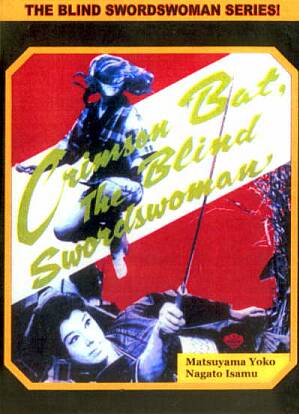 We meet our heroine Oichi as a young child, who has just been being abandoned by her mother – not sure what happened to father, but we later discover Mom’s a prostitute, so can probably fill in the blanks ourselves. To make matters worse, the tree under which Oichi takes shelter from a storm is struck by lightning, rendering her totally blind, in a way that’s – probably wisely – left medically unexplained. However, she is then taken in by a kind gentleman, who brings her up, and on into adulthood.
We meet our heroine Oichi as a young child, who has just been being abandoned by her mother – not sure what happened to father, but we later discover Mom’s a prostitute, so can probably fill in the blanks ourselves. To make matters worse, the tree under which Oichi takes shelter from a storm is struck by lightning, rendering her totally blind, in a way that’s – probably wisely – left medically unexplained. However, she is then taken in by a kind gentleman, who brings her up, and on into adulthood.She’s no luckier with her foster parent, who is murdered by a former associate, Devil Denzou (Amatsu); she is saved from the same fate by a wandering samurai. He sees her potential and trains her in the way of the sword, to the point where she has surpassed him. But she mentions the M-word – “marriage” – and he, too, exits like a, er, bat out of hell. On subsequent travels, she uses her skills to save yet another man from being lynched, and eventually, all these disparate plot threads join up, more or less. Though others, such as the woman with a killer yo-yo [GoGo Yubari’s ancestor?] just kinda drift out of the plot.
The film is at its best when there is the threat of violence; much like Sergio Leone, the lead-up lasts much longer than the actual acts, with the director ratcheting up the tension. For example, there’s one scene where Oichi visits a gambling parlour to raise money, and from the moment she sits down, you know it’s just a matter of time before her sword comes out of its red sheath (which presumably is the origin of her name – that, and the copious blood that tends to get sprayed when she’s around). There’s also a nice visual sense at work throughout here, particularly in lighting, which enhances proceedings nicely.
And, being honest, the actual drama needs all the help it can get, since it seems limp in comparison, though allowance should likely be made for the dubbing. That, however, can’t explain the bouncing back and forth in time, which may induce temporal nausea in susceptible viewers; it feels as if the finished film got tossed in the air and is shown in the order it hit the ground. And while there’s a decent “ah-hah!” when everything ties up, this isn’t enough to justify the lengthy set-up. Fewer plot threads, explored in depth, would be a major improvement.
Dir: Matsuda Teiki
Continue reading →
Star: Yoko Matsuyama, Isamu Nagato, Jun Tatara, Satoshi Amatsu
a.k.a. Mekura No Oichi Monogatari: Makkana Nagaredoni - Trapped, the Crimson Bat
★★★★

 Later that same year (1969), Oichi was back in action, and at the start of Trapped, seems quite content with her life as a bounty-huntress. She has even adopted an orphan, just as she herself was taken in herself, but two things wreck this relatively happy situation. She discovers her protege is really a runaway, not an orphan, and consequently has to abandon her – again, as she was discarded. Worse yet, she incurs the wrath of fellow bounty-huntress Oen (Matsuoka), a kitten with a whip and pockets full of venomous snakes, who leaves Oichi for dead. Luckily, she is nursed back to health by Matsuka (Irikawa), a farmer who doesn’t care about her shady past, and Oichi discovers the joys of a simpler existence – specifically, one not involving the slaughter of criminals for cash. Of course, the inevitable eventually happens: local thug Bunzo (Abe) starts taking the locals’ rice stocks, with Oen closely in tow. No prizes for guessing that the quiet life isn’t going to last long, especially after Matsuka is manipulated by Oen into owing a gambling debt to Bunzo.
Later that same year (1969), Oichi was back in action, and at the start of Trapped, seems quite content with her life as a bounty-huntress. She has even adopted an orphan, just as she herself was taken in herself, but two things wreck this relatively happy situation. She discovers her protege is really a runaway, not an orphan, and consequently has to abandon her – again, as she was discarded. Worse yet, she incurs the wrath of fellow bounty-huntress Oen (Matsuoka), a kitten with a whip and pockets full of venomous snakes, who leaves Oichi for dead. Luckily, she is nursed back to health by Matsuka (Irikawa), a farmer who doesn’t care about her shady past, and Oichi discovers the joys of a simpler existence – specifically, one not involving the slaughter of criminals for cash. Of course, the inevitable eventually happens: local thug Bunzo (Abe) starts taking the locals’ rice stocks, with Oen closely in tow. No prizes for guessing that the quiet life isn’t going to last long, especially after Matsuka is manipulated by Oen into owing a gambling debt to Bunzo.This is a fine movie, with Matusoka in particular a grand foil for the heroine, her hair covering one half of her face like a veil, and the other half usually displaying a near-psychotic expression. Oichi’s struggles to leave her past behind feel almost like Shakespearean tragedy, and the final shots of the film, while a sudden way to end, hint strongly at an endless, futile struggle. To paraphrase George Orwell, if you want a picture of the future, imagine a Samurai sword slicing up an opponent…forever. Downbeat? Hell, yes. Wouldn’t have it any other way.
The action is decent too, with Matsuyama definitely operating a step above her first outing; although these aren’t usually so much fights, more the swift dispatch of one or more opponents, that’s par for the chambara genre. Matsuka is somewhat of an enigma as a character – it’s hard to see why Oichi falls for him, and the whole “orphan” plotline is not well handled. In particular, it’s lacking any kind of background, to the extent it feels like an entire film was missing. The rest of the story though, is well-crafted and packs a solid wallop; you could certainly argue that this is the best flight of the Crimson Bat.
Dir: Matsuda Teiki
Continue reading →
Stars: Yoko Matsuyama, Yasunori Irikawa, Kikko Matsuoka, Toru Abe
a.k.a. Mekura No Oichi Monogatari: Jigoku Hada - Watch Out, Crimson Bat!
★★
 The third entry in the series saw a new director, and unfortunately, a marked turn for the worse, largely because the focus drifts off Oichi. It starts briskly enough, with the heroine coming into possession of a new, effective formula for gunpowder, something barely known at the time in Japan. Understandably, this makes her the focus of attention, in particular for a group with an interest in profiting from the discovery.
The third entry in the series saw a new director, and unfortunately, a marked turn for the worse, largely because the focus drifts off Oichi. It starts briskly enough, with the heroine coming into possession of a new, effective formula for gunpowder, something barely known at the time in Japan. Understandably, this makes her the focus of attention, in particular for a group with an interest in profiting from the discovery.I have a number of qualms with the storyline here, not least the concept that “weapons of mass destruction” (as gunpowder was, when compared to the arrows and swords prevalent during this era) are safe in any hands. Moral doubts aside, the main flaw is the introduction of characters such as Gennosuke (Ibuku) and, worse still, an immensely irritating pair of teenage orphans. Together, they succeed in making Oichi feel like a supporting character in her own movie, and she is almost entirely absent from action in the middle portion.
By the time she rides to the rescue…yes, I said “rides”, her previously unmentioned equestrian skills being hand-waved away with “the horse knows where it’s going”…the film is pretty much dead in the water. The final battle does mark another step up in scale, with Matsuyama’s skills again clearly improved, and the quantity of enemies dispatched again setting a high-water mark, even if Gennosuke gets to take out almost as many as Oichi, and the way in which the villainous henchman suddenly switches sides is laughable. In marked contrast to its two predecessors, this does have a proper ending, tying up the loose threads in a satisfying, if conventional, way. It isn’t enough to rescue the day, with interest having succumbed at a disturbingly early point.
In its incarnation as Samurai Woman (left), I believe this was the only installment to see a release in the UK. When first seen, over a decade ago, it was unimpressive, and it remains weak, particularly when viewed from an action heroine perspective. But even in general terms, it’s a poor piece of cinematic storytelling.
Dir: Hirokazu Ichimura
Continue reading →
Stars: Yoko Matsuyama, Goro Ibuki, Kiyoko Inoue, Asahi Kurizuka
a.k.a. Mekura No Oichi Monogatari: Midare Gasa - Crimson Bat: Wanted, Dead or Alive
★★★½
 Director Ichimura returned for the fourth episode, and despite similar problems as the third installment – most obviously, an apparent doubt that Oichi’s character can hold the viewer’s interest by herself – makes a much better stab at things here. Bounty-hunter Oichi finds out what life is like on the other side of the law, after she helps rescue an unwilling bride from a local magistrate; he slaps a 100 gold-piece reward on her head, which naturally, brings other bounty-hunters on her trail, led by Sankuro (Meguro).
Director Ichimura returned for the fourth episode, and despite similar problems as the third installment – most obviously, an apparent doubt that Oichi’s character can hold the viewer’s interest by herself – makes a much better stab at things here. Bounty-hunter Oichi finds out what life is like on the other side of the law, after she helps rescue an unwilling bride from a local magistrate; he slaps a 100 gold-piece reward on her head, which naturally, brings other bounty-hunters on her trail, led by Sankuro (Meguro).She ends up in a fishing village, where the “evil property developer” subplot makes a surprising appearance, despite the historical era. The reconstruction of the harbour threatens to put the locals out of work, but a plot is afoot among the local authorities to pay them only one gold piece each in compensation, rather than the 15 gold pieces actually provided by the federal government. Residents, officials, bounty-hunters and Oichi all inevitably collide, including one character played by Tetsuro Tamba, who remains even now one of the most respected (and prolific – the IMDB lists 193 films for him!) actors in Japanese cinema.
There’s a lot of devious double-crossing and deception here, which is okay to watch, but isn’t really the reason we watch these things. And that it also turns out to be Sankuro’s birthplace is too much of a fluke to swallow. Fortunately, it all builds nicely to an extended finale, where our heroine (now also framed for the murder of a village elder) gets a chance to take out her aggression and resentment on all those who have turned her life into that of a hunted animal. It’s a great urban battle, through the town which is being demolished around her, in and out of buildings until she finally confronts the chief villain of the piece.
Though this was the last entry in the series, there isn’t much sense of closure at the end, with (and I trust I’m not really spoiling this for anyone) Oichi merely walking off into the sunset, alone again, naturally. One senses Shochiku were hoping to continue, but for whatever reason – most likely box-office success, or rather, the lack thereof – it never materialised. However, for a series from the 60’s, it was undeniably ahead of its time, and most of the films have survived the passage of three and a half decades in an impressive style. If any enterprising DVD company were to snap them up, the rewards would likely be significant.
Dir: Hirokazu Ichimura
Continue reading →
Stars: Yoko Matsuyama, Yuki Meguro, Tetsuro Tanaba, Reiko Oshida
a.k.a. Mekura No Oichi Monogatari: Inochi Moraimasu





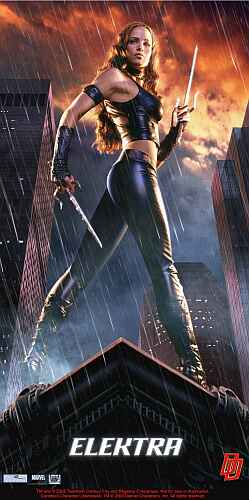 While 2003 has been touted as the Year of the Comic-book Movie, those centred around heroines have been notable by their absence. Sure, X-Men 2, League of Extraordinary Gentlemen and Daredevil have then in supporting roles, but going by the example of the last-named, anyone expecting much is likely to be sorely disappointed. Elektra, one of the toughest, deepest, most twisted characters in comics history – at least in the Bill Sienkiewicz/Frank Miller incarnation – was reduced to little more than a simplistic sidebar of little relevance. Credit to Jennifer Garner for doing what she could, but it’s safe to say that we’re not awaiting the touted Elektra spinoff with anything more than a “that’s nice” level of anticipation.
While 2003 has been touted as the Year of the Comic-book Movie, those centred around heroines have been notable by their absence. Sure, X-Men 2, League of Extraordinary Gentlemen and Daredevil have then in supporting roles, but going by the example of the last-named, anyone expecting much is likely to be sorely disappointed. Elektra, one of the toughest, deepest, most twisted characters in comics history – at least in the Bill Sienkiewicz/Frank Miller incarnation – was reduced to little more than a simplistic sidebar of little relevance. Credit to Jennifer Garner for doing what she could, but it’s safe to say that we’re not awaiting the touted Elektra spinoff with anything more than a “that’s nice” level of anticipation. I usually start watching this in a sense of disbelief, since it’s certainly not the most immediately convincing of movies. However, there’s a point near the middle which has in quick succession an amazing action sequence and two revelations, one touching, one tragic, and I realise that I am, yet again, utterly buying into the characters, storyline and setting. Disbelief simply ceases to be an option, and by the end, I know why this is among my all-time favourites, not just in the action heroine genre, but among all cinema.
I usually start watching this in a sense of disbelief, since it’s certainly not the most immediately convincing of movies. However, there’s a point near the middle which has in quick succession an amazing action sequence and two revelations, one touching, one tragic, and I realise that I am, yet again, utterly buying into the characters, storyline and setting. Disbelief simply ceases to be an option, and by the end, I know why this is among my all-time favourites, not just in the action heroine genre, but among all cinema.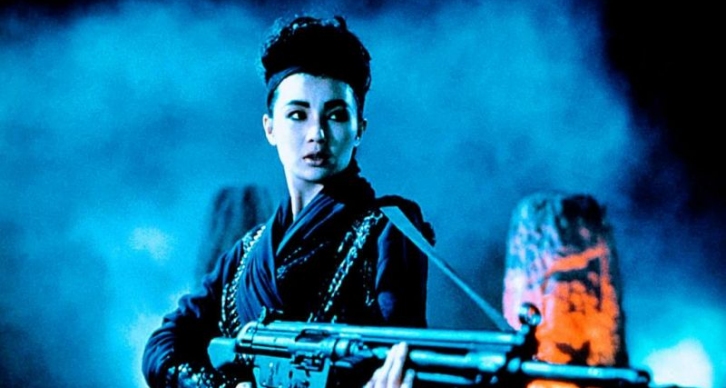

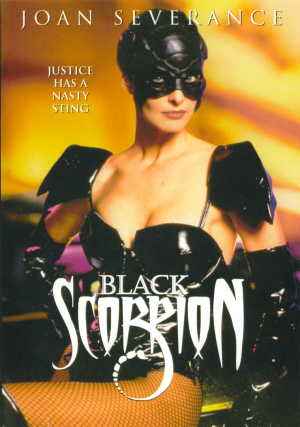 Roger Corman is a man without shame – and that’s in no way intended as an insult. He simply utilises any resource to the best of its ability, as is shown by the
Roger Corman is a man without shame – and that’s in no way intended as an insult. He simply utilises any resource to the best of its ability, as is shown by the 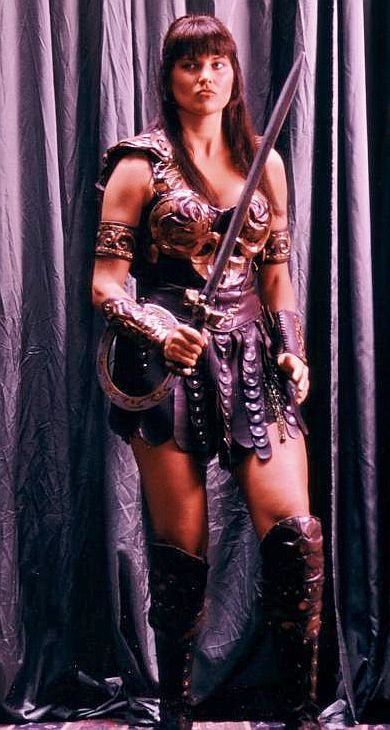
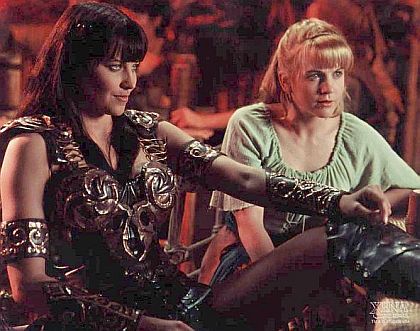 There was enormous, often ferocious debate among fandom over the nature of Xena and Gabrielle’s relationship, some asserting they were a lesbian couple. While both showed plenty of evidence of heterosexuality, there was a lot of content open to interpretation – much of it absolutely deliberate, and known as “subtext” in Xena fandom. I never found it convincing. My issue with it was not one of sexuality, simply compatibility: Xena and Gabrielle were absolute opposites, in background, upbringing, personality and approach. They just didn’t “fit” each other, from what I could see, and there was no chemistry visible. Xena and Hercules: I could see that. Xena and the Queen of the Amazons: no problem there either. But Xena and Gabrielle? Sorry. Not buying this. It also played into the stereotype that any strong woman
There was enormous, often ferocious debate among fandom over the nature of Xena and Gabrielle’s relationship, some asserting they were a lesbian couple. While both showed plenty of evidence of heterosexuality, there was a lot of content open to interpretation – much of it absolutely deliberate, and known as “subtext” in Xena fandom. I never found it convincing. My issue with it was not one of sexuality, simply compatibility: Xena and Gabrielle were absolute opposites, in background, upbringing, personality and approach. They just didn’t “fit” each other, from what I could see, and there was no chemistry visible. Xena and Hercules: I could see that. Xena and the Queen of the Amazons: no problem there either. But Xena and Gabrielle? Sorry. Not buying this. It also played into the stereotype that any strong woman 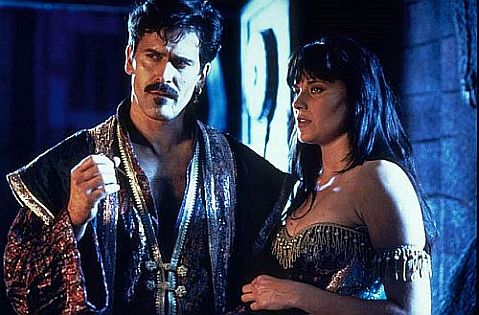 It’s assumed viewers are at least somewhat familiar with Xena’s background, as she is first seen burying her armour in an effort to bury her past. Of course, this is about as successful as it usually is in fiction, and it’s not long before she’s saving villagers, including Gabrielle, from slavery. That includes an aerial battle atop platforms, which is the first sign of the show’s strong influence from Hong Kong action films; it was using wirework, in a way that predated its popular arrival in Hollywood. Similarly, the stunning New Zealand locations foreshadow Lord of the Rings, to the extent that I kept expecting to see hobbits gamboling along in Xena’s wake.
It’s assumed viewers are at least somewhat familiar with Xena’s background, as she is first seen burying her armour in an effort to bury her past. Of course, this is about as successful as it usually is in fiction, and it’s not long before she’s saving villagers, including Gabrielle, from slavery. That includes an aerial battle atop platforms, which is the first sign of the show’s strong influence from Hong Kong action films; it was using wirework, in a way that predated its popular arrival in Hollywood. Similarly, the stunning New Zealand locations foreshadow Lord of the Rings, to the extent that I kept expecting to see hobbits gamboling along in Xena’s wake. The defining moment of Xena’s sophomore season didn’t take place in any episode. In fact, it didn’t even take place in New Zealand, but thousands of miles away, During a rehearsal for an appearance on The Tonight show with Jay Leno, Lucy Lawless was thrown off a horse after it lost its footing, and broke her pelvis. It’s interesting to compare the reaction of the producers to what the Tapert/Raimi team did when the star of Spartacus, Andy Whitfield, was similarly a victim of severe misfortune, more than a decade later. There, they put the show entirely on hold and opted instead to film a prequel without him.
The defining moment of Xena’s sophomore season didn’t take place in any episode. In fact, it didn’t even take place in New Zealand, but thousands of miles away, During a rehearsal for an appearance on The Tonight show with Jay Leno, Lucy Lawless was thrown off a horse after it lost its footing, and broke her pelvis. It’s interesting to compare the reaction of the producers to what the Tapert/Raimi team did when the star of Spartacus, Andy Whitfield, was similarly a victim of severe misfortune, more than a decade later. There, they put the show entirely on hold and opted instead to film a prequel without him. In terms of style and approach, the show covers even more ground here than the first time, from absolutely froth to grim darkness. Xena even gets crucified by Julius Caesar in one episode [confusingly, the actor responsible also crops up later, playing Cupid, complete with fluffy wings…]. I’m sure I’m not the only one who found themselves whistling Always Look on the Bright Side of Life, during the scene shown above right. Another unwitting Python reference is the wretched Here She Comss, Miss Amphipolis, a dreadful tale of drag-queen empowerment, featuring perhaps the least convincing female impersonator since John Cleese put on a dress – as on the left, watch that Adam’s apple
In terms of style and approach, the show covers even more ground here than the first time, from absolutely froth to grim darkness. Xena even gets crucified by Julius Caesar in one episode [confusingly, the actor responsible also crops up later, playing Cupid, complete with fluffy wings…]. I’m sure I’m not the only one who found themselves whistling Always Look on the Bright Side of Life, during the scene shown above right. Another unwitting Python reference is the wretched Here She Comss, Miss Amphipolis, a dreadful tale of drag-queen empowerment, featuring perhaps the least convincing female impersonator since John Cleese put on a dress – as on the left, watch that Adam’s apple  I used to be a Xena fan; for the first couple of series, I was a die-hard, never missed an episode, bought the merchandise, went to the gatherings, etc. I loved (with one exception) the supporting cast – Joxer, Ares, Autolycus – and still reckon Callisto remains one of the great TV villainesses of all time.
I used to be a Xena fan; for the first couple of series, I was a die-hard, never missed an episode, bought the merchandise, went to the gatherings, etc. I loved (with one exception) the supporting cast – Joxer, Ares, Autolycus – and still reckon Callisto remains one of the great TV villainesses of all time.
 The 1980’s were the Golden Era for action heroines in Hong Kong cinema. Names like Cynthia Khan (a.k.a. Cynthia Yeoh), Michelle Khan, Yukari Oshima, Cynthia Rothrock and Moon Lee all came to prominence in the decade. Just sliding in before the bubble burst was Jade Leung, who came out of nowhere to win Best Newcomer at the Hong Kong Film Awards for her performance in 1991’s Black Cat. Jade was born in the then-British colony, November 23rd 1969, but spent four of her later teenage years in Switzerland, where she studied fashion and learned French. In 1990, she returned to Hong Kong and was one of 200+ actresses to audition for Steven Shin, director of Black Cat. She won out, despite her lack of experience, and underwent a rigorous training program to get in shape for the movie.
The 1980’s were the Golden Era for action heroines in Hong Kong cinema. Names like Cynthia Khan (a.k.a. Cynthia Yeoh), Michelle Khan, Yukari Oshima, Cynthia Rothrock and Moon Lee all came to prominence in the decade. Just sliding in before the bubble burst was Jade Leung, who came out of nowhere to win Best Newcomer at the Hong Kong Film Awards for her performance in 1991’s Black Cat. Jade was born in the then-British colony, November 23rd 1969, but spent four of her later teenage years in Switzerland, where she studied fashion and learned French. In 1990, she returned to Hong Kong and was one of 200+ actresses to audition for Steven Shin, director of Black Cat. She won out, despite her lack of experience, and underwent a rigorous training program to get in shape for the movie.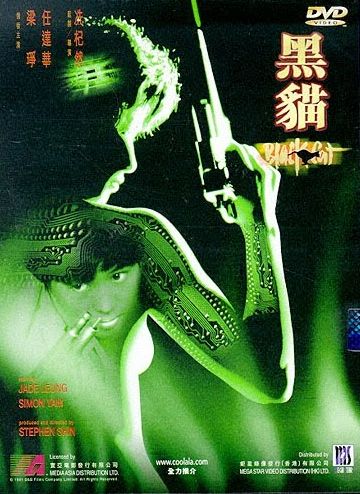
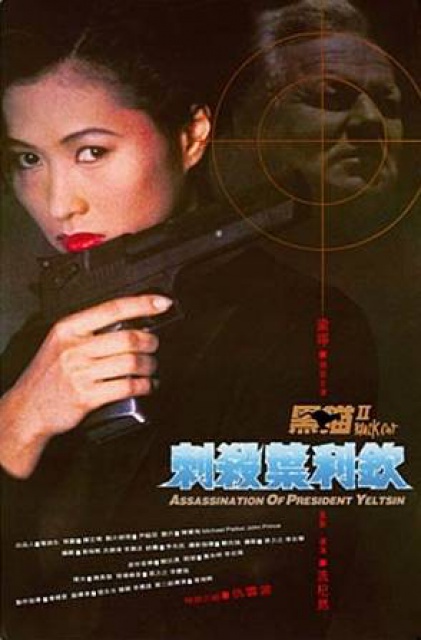
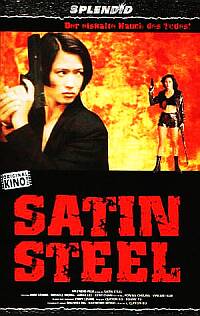


 This film is a 90-minute explanation of why Jade Leung’s star never took off. While some decisions Michelle Yeoh made might have been questionable, at least her films were rarely boring, and never down to the level of this piece of tedious dreck. It depicts the struggles of a class of policewomen (including Jade), to become part of the elite. The idea certainly has potential – the Inspector Wears Skirts series has a similar premise – but here, there is almost no character given to any of the girls; they all blur into each other, like a dozen GI Jane-wannabes.
This film is a 90-minute explanation of why Jade Leung’s star never took off. While some decisions Michelle Yeoh made might have been questionable, at least her films were rarely boring, and never down to the level of this piece of tedious dreck. It depicts the struggles of a class of policewomen (including Jade), to become part of the elite. The idea certainly has potential – the Inspector Wears Skirts series has a similar premise – but here, there is almost no character given to any of the girls; they all blur into each other, like a dozen GI Jane-wannabes.



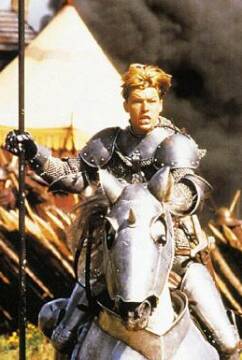
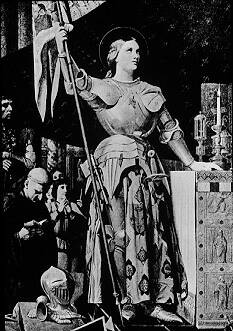 Born in the French province of Champagne in 1412, to a peasant farmer, Joan (or Jeanne – I’ll largely stick to the Anglicization) never learned to read or write, but was regarded by her contemporaries as a highly pious child. It was at the age of 13 that she first heard voices, but it took several years before they convinced her to leave home and help the French king, who was engaged in a battle to liberate the country from England. She presented herself to the local commander, who was skeptical at first, but was eventually convinced after Joan reported news of an English defeat before official confirmation arrived. Joan, clad in male attire to protect her modesty, travelled to see the king, and convinced him of the legitimacy of his claim to the throne, despite a faction of the court strongly opposing her influence. Her faith, simplicity and honesty won the day, and she acquired her sword, found buried behind an altar, in the exact spot she said it would be.
Born in the French province of Champagne in 1412, to a peasant farmer, Joan (or Jeanne – I’ll largely stick to the Anglicization) never learned to read or write, but was regarded by her contemporaries as a highly pious child. It was at the age of 13 that she first heard voices, but it took several years before they convinced her to leave home and help the French king, who was engaged in a battle to liberate the country from England. She presented herself to the local commander, who was skeptical at first, but was eventually convinced after Joan reported news of an English defeat before official confirmation arrived. Joan, clad in male attire to protect her modesty, travelled to see the king, and convinced him of the legitimacy of his claim to the throne, despite a faction of the court strongly opposing her influence. Her faith, simplicity and honesty won the day, and she acquired her sword, found buried behind an altar, in the exact spot she said it would be.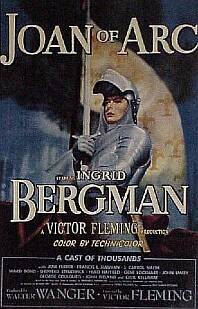 This was nothing more than a show trial, despite the efforts of those in charge to find support: according to biographer Jules Michelet, one jurist said “that everything about the trial was wrong; that it failed to respect the proper forms; that the assessors were not free; that the sessions were held in secrecy; that the accused…could not be expected to argue with learned doctors” and finished by declaring that it “was a trial to impugn the honour of the prince whose cause this girl is supporting; you should frankly say so.” Perhaps wisely, the holder of these opinions opted to leave France immediately for the safety of Rome.
This was nothing more than a show trial, despite the efforts of those in charge to find support: according to biographer Jules Michelet, one jurist said “that everything about the trial was wrong; that it failed to respect the proper forms; that the assessors were not free; that the sessions were held in secrecy; that the accused…could not be expected to argue with learned doctors” and finished by declaring that it “was a trial to impugn the honour of the prince whose cause this girl is supporting; you should frankly say so.” Perhaps wisely, the holder of these opinions opted to leave France immediately for the safety of Rome.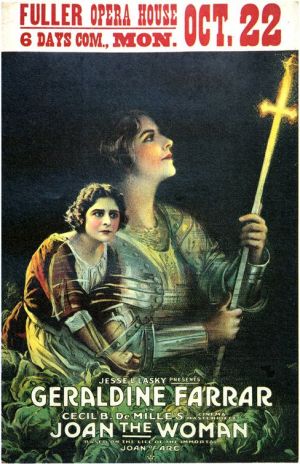 I don’t watch many silent films: it’s such an entirely different experience, obviously, much less driven by dialogue and more by gestures, leading to a style that can look extremely over-theatrical to the modern viewer. My efforts to enjoy the likes of Nosferatu, for example, have usually ended in my providing an accompaniment of snoring, to be honest. This was much better. Despite a running time of over two hours, this 1916 DeMille epic successfully held my interest, as it told the story of Joan of Arc. The framing device uses the then-contemporary World War I, and an English soldier (Reid) finds Joan’s sword in the trenches, the night before a dangerous mission [Interesting how the English are the enemy in the back-story, but the good guys “now” – at the time of release, America was still several months from entering the war, on the British side]. He then experiences a flashback vision, taking him to medieval France, where he is an English soldier saved by Joan (Farrar) in her milkmaid days. We follow her for the story you know, becoming the inspiration for the French army to defeat the English, before her capture, trial for heresy and – I trust I’m not spoiling this – burning at the stake.
I don’t watch many silent films: it’s such an entirely different experience, obviously, much less driven by dialogue and more by gestures, leading to a style that can look extremely over-theatrical to the modern viewer. My efforts to enjoy the likes of Nosferatu, for example, have usually ended in my providing an accompaniment of snoring, to be honest. This was much better. Despite a running time of over two hours, this 1916 DeMille epic successfully held my interest, as it told the story of Joan of Arc. The framing device uses the then-contemporary World War I, and an English soldier (Reid) finds Joan’s sword in the trenches, the night before a dangerous mission [Interesting how the English are the enemy in the back-story, but the good guys “now” – at the time of release, America was still several months from entering the war, on the British side]. He then experiences a flashback vision, taking him to medieval France, where he is an English soldier saved by Joan (Farrar) in her milkmaid days. We follow her for the story you know, becoming the inspiration for the French army to defeat the English, before her capture, trial for heresy and – I trust I’m not spoiling this – burning at the stake. This film’s origins as a stage play are painfully apparent, and you can also see why the distributor’s felt it needed to have 45 minutes cut out before it could be released, as frankly, it’s a bit of a bore. The battle to recapture Orleans is the only action of note here, even though that represented the start of the Maid’s campaign to restore France to its proper ruler (Ferrer), rather than the end. After that, this more or less skips forward to his coronation, then Joan’s capture, spending the rest of the movie – and there’s a lot of it – going through the trial, and the railroading of the heroine into, first throwing herself on the church’s mercy, then recanting her recantation and returning to wearing men’s clothes, thereby sealing her fate. There’s not much here which you won’t have seen before, if you’ve seen any of the other versions of the story, touching the usual bases from Joan’s revelations that she’s going to be the saviour of France, through her trip to see the Dauphin, and so on. It does downplay the “voices” aspect, especially early on, perhaps a wise move since it’s difficult to depict, without making her seem like a religious fruitcake.
This film’s origins as a stage play are painfully apparent, and you can also see why the distributor’s felt it needed to have 45 minutes cut out before it could be released, as frankly, it’s a bit of a bore. The battle to recapture Orleans is the only action of note here, even though that represented the start of the Maid’s campaign to restore France to its proper ruler (Ferrer), rather than the end. After that, this more or less skips forward to his coronation, then Joan’s capture, spending the rest of the movie – and there’s a lot of it – going through the trial, and the railroading of the heroine into, first throwing herself on the church’s mercy, then recanting her recantation and returning to wearing men’s clothes, thereby sealing her fate. There’s not much here which you won’t have seen before, if you’ve seen any of the other versions of the story, touching the usual bases from Joan’s revelations that she’s going to be the saviour of France, through her trip to see the Dauphin, and so on. It does downplay the “voices” aspect, especially early on, perhaps a wise move since it’s difficult to depict, without making her seem like a religious fruitcake.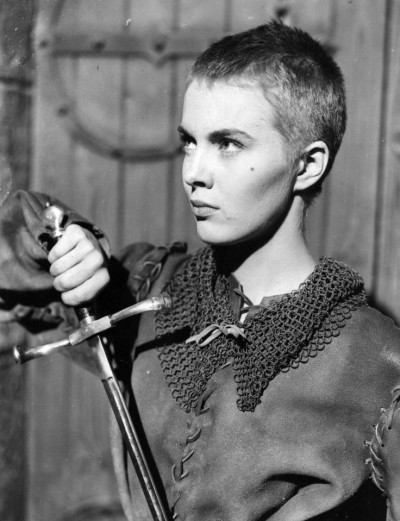

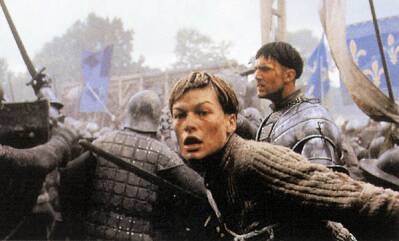 Joan’s capture, trial and execution are fairly close to the truth, though in reality, the King was less involved and more concerned for Joan than shown. It certainly is reasonable to suggest that a naive innocent such as Joan would have been used for political ends. Once she’d outlasted her usefulness – and with the king on the throne, she quickly became more a hindrance than a help – she would have needed to be disposed of. Must confess, I quite like the concept of Joan as a medieval version of Lee Harvey Oswald. Dustin Hoffman’s appearance as Joan’s conscience is another neat touch, and his sarcasm works well. Indeed, the film is one good performance from being excellent. The bad news is, it’s Jovovich who is the culprit (a messenger who deserves to be shot?), though Besson and co-writer Andrew Birkin perhaps warrant most of the criticism for twisting facts and characters in order to fit a predetermined goal. Their Joan is so far from the historical record, they’d have been better off placing their character in an entirely fictitious setting.
Joan’s capture, trial and execution are fairly close to the truth, though in reality, the King was less involved and more concerned for Joan than shown. It certainly is reasonable to suggest that a naive innocent such as Joan would have been used for political ends. Once she’d outlasted her usefulness – and with the king on the throne, she quickly became more a hindrance than a help – she would have needed to be disposed of. Must confess, I quite like the concept of Joan as a medieval version of Lee Harvey Oswald. Dustin Hoffman’s appearance as Joan’s conscience is another neat touch, and his sarcasm works well. Indeed, the film is one good performance from being excellent. The bad news is, it’s Jovovich who is the culprit (a messenger who deserves to be shot?), though Besson and co-writer Andrew Birkin perhaps warrant most of the criticism for twisting facts and characters in order to fit a predetermined goal. Their Joan is so far from the historical record, they’d have been better off placing their character in an entirely fictitious setting.
 However, the main difference between this and The Messenger is that Joan of Arc is convincing. Perhaps with the advantage of having extra time (the DVD of the miniseries runs 189 minutes), they make the effort to show her interacting with other characters, and Sobieski’s calm, complete assurance is a striking contrast to Jovovich. The viewer can see why people would believe her, and it naturally follows they will too – Sobieski’s Emmy nomination was entirely well-deserved. Despite playing fast and loose with the facts (another example: Joan’s brother was not killed in battle, but lived to see her trial verdict overturned), this strong central performance holds the film together and, with the aid of the other fine actors, makes it eminently watchable. It may not be historically accurate, but it does a fine job of explaining why her myth is still honoured in the third millennium, without coming down in one camp or the other regarding the source of her visions. There are few TV miniseries worth watching, and fewer still worth owning, but this one comes highly recommended.
However, the main difference between this and The Messenger is that Joan of Arc is convincing. Perhaps with the advantage of having extra time (the DVD of the miniseries runs 189 minutes), they make the effort to show her interacting with other characters, and Sobieski’s calm, complete assurance is a striking contrast to Jovovich. The viewer can see why people would believe her, and it naturally follows they will too – Sobieski’s Emmy nomination was entirely well-deserved. Despite playing fast and loose with the facts (another example: Joan’s brother was not killed in battle, but lived to see her trial verdict overturned), this strong central performance holds the film together and, with the aid of the other fine actors, makes it eminently watchable. It may not be historically accurate, but it does a fine job of explaining why her myth is still honoured in the third millennium, without coming down in one camp or the other regarding the source of her visions. There are few TV miniseries worth watching, and fewer still worth owning, but this one comes highly recommended.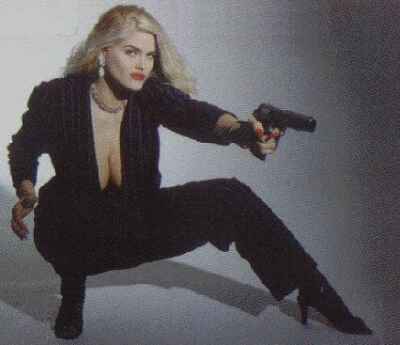 “Twin towers”
“Twin towers” The obvious point of comparison for Smith would be Pamela Anderson, another Playboy playmate who moved into films of doubtful quality, but any such comparison would be unfair. To Anderson, that is, who given the right role, is not actually too bad. With Smith, you get the feeling she simply has no talent, and any character would be a stretch, let alone the Shakespeare-aware, ace helicopter pilot and crackshot she is supposed to portray in this shameless Die Hard clone.
The obvious point of comparison for Smith would be Pamela Anderson, another Playboy playmate who moved into films of doubtful quality, but any such comparison would be unfair. To Anderson, that is, who given the right role, is not actually too bad. With Smith, you get the feeling she simply has no talent, and any character would be a stretch, let alone the Shakespeare-aware, ace helicopter pilot and crackshot she is supposed to portray in this shameless Die Hard clone.
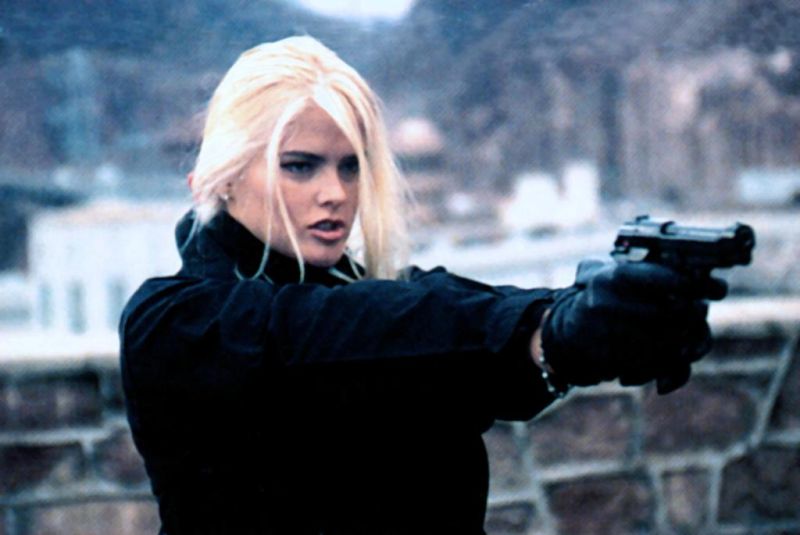
 Okay, her swansong won’t be up there with James Dean’s or Bruce Lee’s, but this does at least sense its own idiocy, rendering the movie somewhat bullet-proof, critically speaking. It’s supposed to be dumb, wildly implausible and hideously over-acted. So condemning it for these flaws is complaining because your hotdog tastes of meat. A trio of shape-shifting aliens land on Earth to protect it from the scum of the universe. Thanks to their first encounter with our culture coming in the shape of a porno mag, they opt for the form of attractive women. Two end up getting jobs as FX/stunt people in Hollywood – a sadly underexplored angle – while the third is…Anna Nicole Smith. Then their nemesis (Laurer, the actress formerly known as Chyna) turns up, taking over the body of a mobster’s wife, and prepares to bring about the end of the world. Can she be stopped?
Okay, her swansong won’t be up there with James Dean’s or Bruce Lee’s, but this does at least sense its own idiocy, rendering the movie somewhat bullet-proof, critically speaking. It’s supposed to be dumb, wildly implausible and hideously over-acted. So condemning it for these flaws is complaining because your hotdog tastes of meat. A trio of shape-shifting aliens land on Earth to protect it from the scum of the universe. Thanks to their first encounter with our culture coming in the shape of a porno mag, they opt for the form of attractive women. Two end up getting jobs as FX/stunt people in Hollywood – a sadly underexplored angle – while the third is…Anna Nicole Smith. Then their nemesis (Laurer, the actress formerly known as Chyna) turns up, taking over the body of a mobster’s wife, and prepares to bring about the end of the world. Can she be stopped? There’s no doubt this film is, if not cashing in on her death, certainly shrugging its shoulders and taking advantage of an unfortunate situation. I don’t really blame them for that, even if anyone looking for skin will be wasting their time here. In sharp contrast to her previous, ah, body of work, AN’s clothes remain on; as exploitation goes, this is tame and restrained. And that may be the main problem: a failure by the makers to decide which way to go. SF/action or all-out comedy? There’s enough of each to suggest, with greater commitment, either might have worked better. Instead, it comes off as somewhat lukewarm – can’t say we were ever bored, yet I can’t say I was ever more than mildly amused.
There’s no doubt this film is, if not cashing in on her death, certainly shrugging its shoulders and taking advantage of an unfortunate situation. I don’t really blame them for that, even if anyone looking for skin will be wasting their time here. In sharp contrast to her previous, ah, body of work, AN’s clothes remain on; as exploitation goes, this is tame and restrained. And that may be the main problem: a failure by the makers to decide which way to go. SF/action or all-out comedy? There’s enough of each to suggest, with greater commitment, either might have worked better. Instead, it comes off as somewhat lukewarm – can’t say we were ever bored, yet I can’t say I was ever more than mildly amused. It’s perhaps no surprise that Sidaris gravitated towards the action genre, having for many years been a TV sports producer, winning seven Emmys in the process. He also was responsible for the football scenes in M.A.S.H., though director Robertn Altman stiffed him out of credit for that, to Sidaris’s lasting disdain; more than 30 years later,
It’s perhaps no surprise that Sidaris gravitated towards the action genre, having for many years been a TV sports producer, winning seven Emmys in the process. He also was responsible for the football scenes in M.A.S.H., though director Robertn Altman stiffed him out of credit for that, to Sidaris’s lasting disdain; more than 30 years later, 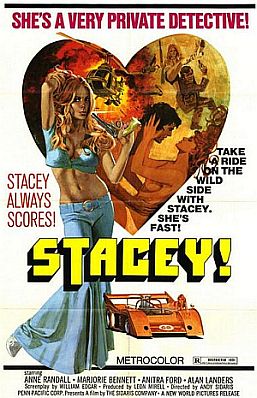 While this wasn’t Sidaris’s first feature – he’d done The Racing Scene, with James Garner in 1967 – this was likely the prototype of the BB&B (Blood, Bullets & Babes) flicks that would become his trademark. If all the elements do not quite mesh in the way they eventually would, they are all present, mostly in the shape of Anne Randall, a former Playboy playmate who plays private investigator Stacey, and looks a bit like Heather Graham.
While this wasn’t Sidaris’s first feature – he’d done The Racing Scene, with James Garner in 1967 – this was likely the prototype of the BB&B (Blood, Bullets & Babes) flicks that would become his trademark. If all the elements do not quite mesh in the way they eventually would, they are all present, mostly in the shape of Anne Randall, a former Playboy playmate who plays private investigator Stacey, and looks a bit like Heather Graham. Female action fans would be well advised to give this a wide berth. Actually, so should everyone else, unless they’re fans of crass sexism, extremely clunky exposition and hideous country & western. Cody Abilene (Hinton) is a PI hired by Countess Luciana (Danning) to look into the export of illegal computer technology to the Russians, centred on the home of Lady Lillian Chamberlain. Who is responsible? Oversexed chauffeur Shane? Daughters Lisa and Anita? Or the maid, Marion? [groan…]
Female action fans would be well advised to give this a wide berth. Actually, so should everyone else, unless they’re fans of crass sexism, extremely clunky exposition and hideous country & western. Cody Abilene (Hinton) is a PI hired by Countess Luciana (Danning) to look into the export of illegal computer technology to the Russians, centred on the home of Lady Lillian Chamberlain. Who is responsible? Oversexed chauffeur Shane? Daughters Lisa and Anita? Or the maid, Marion? [groan…] Also known as Hard Titties in Hawaii – at least in this house – it’s a big step forward as far as the evolution of Sidaris’ work goes. After the flailing around that was Malibu Express, he’s now firmly settled on Hawaii as a location, and jiggly action/adventure as the genre. However, he still unfortunately seems to want to cram lame comedy in there, such as clunky references to his previous films, while many of the actors appear not to have been chosen for their thespian ability – to their credit, Speir and Carlton aren’t particularly the worst offenders.
Also known as Hard Titties in Hawaii – at least in this house – it’s a big step forward as far as the evolution of Sidaris’ work goes. After the flailing around that was Malibu Express, he’s now firmly settled on Hawaii as a location, and jiggly action/adventure as the genre. However, he still unfortunately seems to want to cram lame comedy in there, such as clunky references to his previous films, while many of the actors appear not to have been chosen for their thespian ability – to their credit, Speir and Carlton aren’t particularly the worst offenders.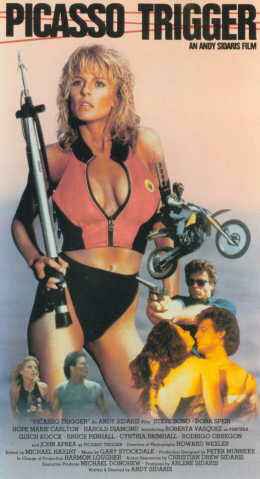 Salazar (Aprea) is a famously devious assassin who gets shot by a sniper just after he donates a painting (of the emblematic ‘Picasso triggerfish’) to a Parisian art gallery. This sparks a series of lethal attacks on undercover federal spy teams who are Salazar’s enemies. But are the various bad-guys, who use all manner of tricks to eliminate government agents, all working for a criminal mastermind?
Salazar (Aprea) is a famously devious assassin who gets shot by a sniper just after he donates a painting (of the emblematic ‘Picasso triggerfish’) to a Parisian art gallery. This sparks a series of lethal attacks on undercover federal spy teams who are Salazar’s enemies. But are the various bad-guys, who use all manner of tricks to eliminate government agents, all working for a criminal mastermind? This one doesn’t really get going until the second half, when the search for a lost hoard of Japanese wartime gold, looted from the Philippines, leads to a remote island. There are CIA agents, revolutionaries, a left-behind Japanese soldier and, of course, our lovely heroines Dona and Taryn (Speir and Carlton) who end up there after their plane crashes in a storm. Or rather, “storm” – you can get a cheap laugh by seeing the bright blue skies as they land in the middle of a clearly hose-supplied downpour. Sidaris probably felt the need to justify their otherwise implausible strip-tease shortly after departure. Or do FAA regulation stipulate pilots must remove their tops in emergencies? Two take-offs for the price of one…
This one doesn’t really get going until the second half, when the search for a lost hoard of Japanese wartime gold, looted from the Philippines, leads to a remote island. There are CIA agents, revolutionaries, a left-behind Japanese soldier and, of course, our lovely heroines Dona and Taryn (Speir and Carlton) who end up there after their plane crashes in a storm. Or rather, “storm” – you can get a cheap laugh by seeing the bright blue skies as they land in the middle of a clearly hose-supplied downpour. Sidaris probably felt the need to justify their otherwise implausible strip-tease shortly after departure. Or do FAA regulation stipulate pilots must remove their tops in emergencies? Two take-offs for the price of one…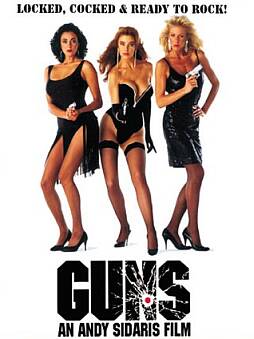 Two federal agents (Speir and Vasquez) are hot on the trail of South American gangster Degas (Estrada), after one of their friends is shot during one of his hits – but perhaps that’s really what he wants? Zipping around from Hawaii to Arizona to Las Vegas, this was the first Sidaris movie I saw, and was probably better than I expected. While obviously not shot on an unlimited budget, most of the deficiencies are made up for in energy and a host of interesting characters.
Two federal agents (Speir and Vasquez) are hot on the trail of South American gangster Degas (Estrada), after one of their friends is shot during one of his hits – but perhaps that’s really what he wants? Zipping around from Hawaii to Arizona to Las Vegas, this was the first Sidaris movie I saw, and was probably better than I expected. While obviously not shot on an unlimited budget, most of the deficiencies are made up for in energy and a host of interesting characters.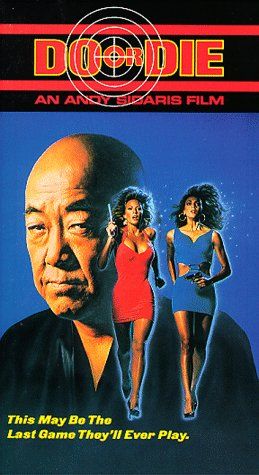 In a filmography not exactly noted for thought-out plots, this maybe counts as one of the thinnest. Donna (Speir) and Nicole (Vasquez) are targeted by death for Kane (Morita) for their interference in his illegal business ventures. But rather than simply bumping them off, as any sane criminal mastermind would do, he informs them of his intentions to send six separate pairs of assassins after them, beginning the next morning. Our pair of federal lovelies head out of Hawaii, little knowing that a tracker has been placed on them, allowing Kane’s to follow them, while their master sits in his apartment and follows the progress of his “game” on a computer display resembling a bad TRS-80 game [younger readers can Google “TRS-80” if they need specifics], as they proceed from Las Vegas to Louisiana, with a motley crew of associated agents in tow, including infamous Meyer model, Pandora Peaks. No prizes for guessing her role.
In a filmography not exactly noted for thought-out plots, this maybe counts as one of the thinnest. Donna (Speir) and Nicole (Vasquez) are targeted by death for Kane (Morita) for their interference in his illegal business ventures. But rather than simply bumping them off, as any sane criminal mastermind would do, he informs them of his intentions to send six separate pairs of assassins after them, beginning the next morning. Our pair of federal lovelies head out of Hawaii, little knowing that a tracker has been placed on them, allowing Kane’s to follow them, while their master sits in his apartment and follows the progress of his “game” on a computer display resembling a bad TRS-80 game [younger readers can Google “TRS-80” if they need specifics], as they proceed from Las Vegas to Louisiana, with a motley crew of associated agents in tow, including infamous Meyer model, Pandora Peaks. No prizes for guessing her role. It’s very easy to mock a film, when the lesbian necking starts before the meaningful dialogue, and is immediately followed by a musical number where Cynthia Brimhall channels the spirit of Jimmy Buffett. Yet the endearing loopiness on display here did a better job of keeping my interest throughout than many movies made with far larger budgets. The plot centers on a jade Buddha, containing a nuclear trigger, which starts off in the hands of Kane (Moore), only for it to be swiped by an undercover agent: she is gunned down, but passes it to Donna (Speir), who has to try and keep it out of Kane’s clutches. However, an unfortunate bout of amnesia leaves her partner Nicole (Vazquez) and the other agents trying to find her first.
It’s very easy to mock a film, when the lesbian necking starts before the meaningful dialogue, and is immediately followed by a musical number where Cynthia Brimhall channels the spirit of Jimmy Buffett. Yet the endearing loopiness on display here did a better job of keeping my interest throughout than many movies made with far larger budgets. The plot centers on a jade Buddha, containing a nuclear trigger, which starts off in the hands of Kane (Moore), only for it to be swiped by an undercover agent: she is gunned down, but passes it to Donna (Speir), who has to try and keep it out of Kane’s clutches. However, an unfortunate bout of amnesia leaves her partner Nicole (Vazquez) and the other agents trying to find her first. Hang on, two movies ago, criminal mastermind Kane was Japanese – now, he’s the son of a Nazi officer who went on the run after the war with a diamond stolen from the Russians? I know I’m watching these all of our order, but still… They even refer to a pendant with a tracking device in it, given to the Japanese version of Kane, even though Moore now appears to be channeling Julian Sands, not Pat Morita. I’m so confused. Still, logic, continuity and coherence are not really the point here, are they?
Hang on, two movies ago, criminal mastermind Kane was Japanese – now, he’s the son of a Nazi officer who went on the run after the war with a diamond stolen from the Russians? I know I’m watching these all of our order, but still… They even refer to a pendant with a tracking device in it, given to the Japanese version of Kane, even though Moore now appears to be channeling Julian Sands, not Pat Morita. I’m so confused. Still, logic, continuity and coherence are not really the point here, are they? While containing many of the same elements as usual e.g. boobs and bombs, this does at least throw in a new angle, in the shape of some Confederate gold buried in the woods since the Civil War – I can only presume Sidaris must have befriended a Civil War re-enactment battalion. Out enjoying a bit of off-road action, amusingly-named federal agent Becky Midnite (Simpson) and her two co-workers stumble across a diary written by one of the soldiers transporting the gold. However, their plans to search for the treasure are disrupted by efforts to kill them, courtesy of mob boss Santiago. He is upset after they shut down his operation that involved shipping drugs in hollowed-out watermelons. Fed up with the ineptness of his minions, he hires even more amusingly-named assassin Jewel Panther (Strain) to carry out what they have failed to do.
While containing many of the same elements as usual e.g. boobs and bombs, this does at least throw in a new angle, in the shape of some Confederate gold buried in the woods since the Civil War – I can only presume Sidaris must have befriended a Civil War re-enactment battalion. Out enjoying a bit of off-road action, amusingly-named federal agent Becky Midnite (Simpson) and her two co-workers stumble across a diary written by one of the soldiers transporting the gold. However, their plans to search for the treasure are disrupted by efforts to kill them, courtesy of mob boss Santiago. He is upset after they shut down his operation that involved shipping drugs in hollowed-out watermelons. Fed up with the ineptness of his minions, he hires even more amusingly-named assassin Jewel Panther (Strain) to carry out what they have failed to do.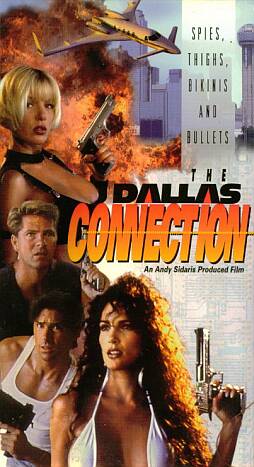 Among Sidaris fans, I imagine arguments over whether this one counts, much like the Never Say Never Again debate among 007 lovers. For this was directed not by Andy, but son Drew; Dad and Mom were merely executive producers. However, the content is much the same, though (and I can’t believe I’m writing this) Drew lacks the subtle touch of Sidaris Sr. Case in point: the very first shot is of the Eiffel Tower, establishing that this is Paris. However, the point is then rammed home with footage of the Arc De Triomphe, Place de la Concorde and Notre Dame. Similarly before the ‘South African’ scenes; we get so much wildlife footage, it feels more like the Discovery Channel.
Among Sidaris fans, I imagine arguments over whether this one counts, much like the Never Say Never Again debate among 007 lovers. For this was directed not by Andy, but son Drew; Dad and Mom were merely executive producers. However, the content is much the same, though (and I can’t believe I’m writing this) Drew lacks the subtle touch of Sidaris Sr. Case in point: the very first shot is of the Eiffel Tower, establishing that this is Paris. However, the point is then rammed home with footage of the Arc De Triomphe, Place de la Concorde and Notre Dame. Similarly before the ‘South African’ scenes; we get so much wildlife footage, it feels more like the Discovery Channel.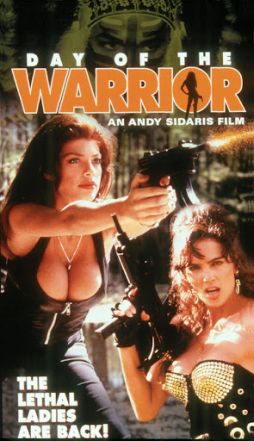 Andy was back on the helm for this one, but appears to have opted to go beyond subtle self-referential digs into full-blown camp, and I tend to think this takes away from the overall experience. The intent is clear when we are brought into the office of Willow Black, the head of L.E.T.H.A.L. (The Legion to Ensure Total Harmony and Law), and find her exercising on a treadmill in an outfit more suited for an exotic dancer. Which makes sense, because if you’re a female agent of LETHAL, you can bet you’ll be going undercover as a stripper or a porn actress – not quite the empowering government job one might expect. It also appears that breast enlargement surgery is required for all such operatives.
Andy was back on the helm for this one, but appears to have opted to go beyond subtle self-referential digs into full-blown camp, and I tend to think this takes away from the overall experience. The intent is clear when we are brought into the office of Willow Black, the head of L.E.T.H.A.L. (The Legion to Ensure Total Harmony and Law), and find her exercising on a treadmill in an outfit more suited for an exotic dancer. Which makes sense, because if you’re a female agent of LETHAL, you can bet you’ll be going undercover as a stripper or a porn actress – not quite the empowering government job one might expect. It also appears that breast enlargement surgery is required for all such operatives.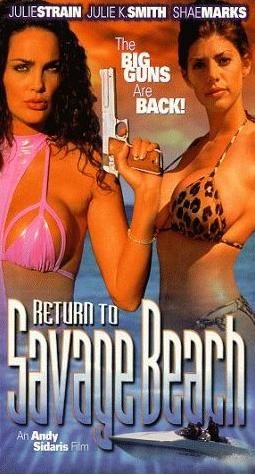 This was Sidaris’s last film, and after the disappointment of Warrior, it’s nice to see him return to a more straightforward approach, with little of the post-modernity attempted there. It is largely a sequel to Savage Beach, with a raid on the LETHAL offices puzzling Willow (Strain) and her agents, because the only thing accessed was the files on that case, which have long been closed. However, it turns out the villain there, Rodrigo (Obregon) did not die in a fiery, explosive-tipped crossbow bolt explosion as thought, and now sports a nifty mask, apparently lifted from a production of Phantom of the Opera. He sends his blonde minion in her submarine(!), along with his ninjas(!!), back to the island to claim a priceless Golden Buddha buried there, and it’s up to Cobra (Smith), Tiger (Marks) and their himbo colleagues, to stop him.
This was Sidaris’s last film, and after the disappointment of Warrior, it’s nice to see him return to a more straightforward approach, with little of the post-modernity attempted there. It is largely a sequel to Savage Beach, with a raid on the LETHAL offices puzzling Willow (Strain) and her agents, because the only thing accessed was the files on that case, which have long been closed. However, it turns out the villain there, Rodrigo (Obregon) did not die in a fiery, explosive-tipped crossbow bolt explosion as thought, and now sports a nifty mask, apparently lifted from a production of Phantom of the Opera. He sends his blonde minion in her submarine(!), along with his ninjas(!!), back to the island to claim a priceless Golden Buddha buried there, and it’s up to Cobra (Smith), Tiger (Marks) and their himbo colleagues, to stop him.
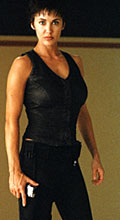 The setting is the near-future, when corporations have taken over, and even the FBI is now the Incorporated Bureau of Investigations. The star is Bobbie Phillips, who plays Kam, a creation of the IBI. She was made as a special agent, with mostly human DNA, but also traces of cougar, falcon and chameleon. This gives her an interesting power: she can make her skin match her surroundings almost perfectly. Fortunately – or not – this skill is also possessed by her clothes, which is a bit of a plot clunker, designed to avoid both the traditional Invisible Man-styled floating shirts, and gratuitous nudity.
The setting is the near-future, when corporations have taken over, and even the FBI is now the Incorporated Bureau of Investigations. The star is Bobbie Phillips, who plays Kam, a creation of the IBI. She was made as a special agent, with mostly human DNA, but also traces of cougar, falcon and chameleon. This gives her an interesting power: she can make her skin match her surroundings almost perfectly. Fortunately – or not – this skill is also possessed by her clothes, which is a bit of a plot clunker, designed to avoid both the traditional Invisible Man-styled floating shirts, and gratuitous nudity.
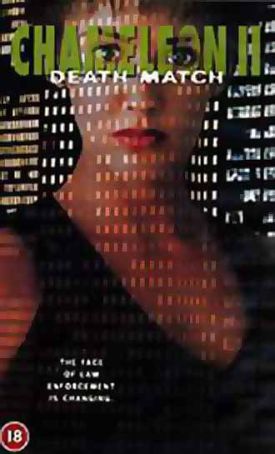
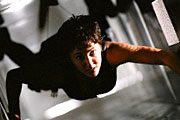 There’s one sequence with Kam scurrying, lightning-fast, up a ventilation shaft (left) and a rather good brawl involving her that made me sit up and pay attention, offering hope for the rest of the movie. It’s a red herring. The last twenty minutes finally stop slavishly cloning Bruce Willis, with the villain not being who you’d expect (though if you think about who played the bad guys in the Die Hard trilogy, it’s not hard to work out). One good twist at the end is Kam recovering the “loot” and using it for her own ends, which extends her nicely amoral attitude. There’s also a nod to Kam’s not-entirely human origins, and how they affect her emotions, which would be a good avenue for future exploration.
There’s one sequence with Kam scurrying, lightning-fast, up a ventilation shaft (left) and a rather good brawl involving her that made me sit up and pay attention, offering hope for the rest of the movie. It’s a red herring. The last twenty minutes finally stop slavishly cloning Bruce Willis, with the villain not being who you’d expect (though if you think about who played the bad guys in the Die Hard trilogy, it’s not hard to work out). One good twist at the end is Kam recovering the “loot” and using it for her own ends, which extends her nicely amoral attitude. There’s also a nod to Kam’s not-entirely human origins, and how they affect her emotions, which would be a good avenue for future exploration.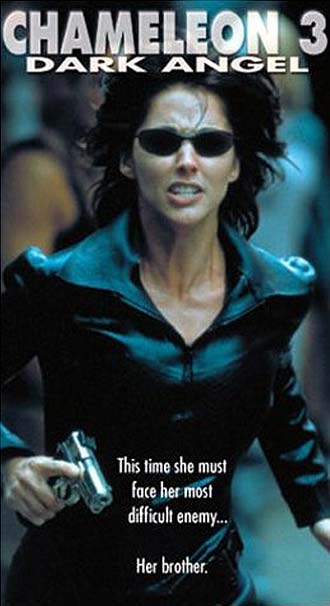
 I imagine no-one genuinely doubts the answer, but this adds a whole new plot twist, especially as the last time the Mongoose activated his weapon, its impact was pretty heavy. What happens when it’s used here is never really shown, and there is some scientific handwaving about the black hole absorbing all the energy, but it would be gratifying to think that it became necessary to destroy the city in order to save it. Not least because Cameron’s Dark Angel
I imagine no-one genuinely doubts the answer, but this adds a whole new plot twist, especially as the last time the Mongoose activated his weapon, its impact was pretty heavy. What happens when it’s used here is never really shown, and there is some scientific handwaving about the black hole absorbing all the energy, but it would be gratifying to think that it became necessary to destroy the city in order to save it. Not least because Cameron’s Dark Angel